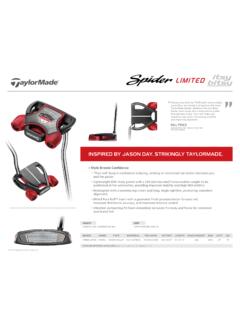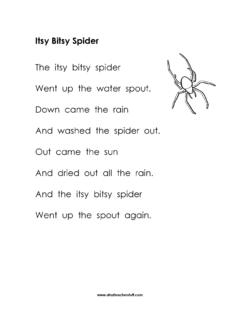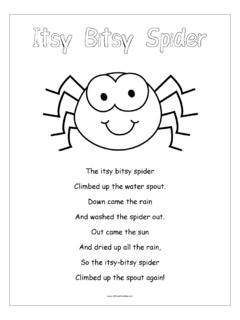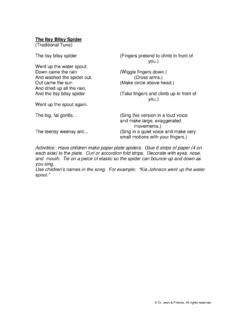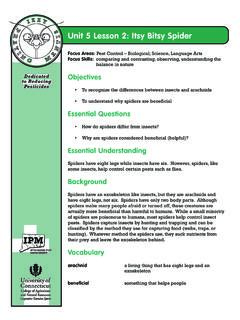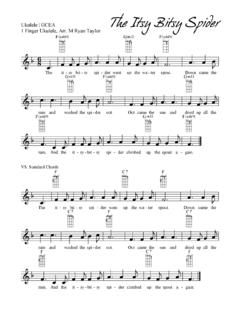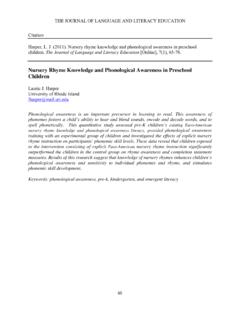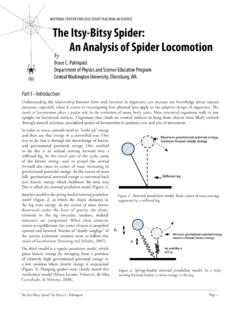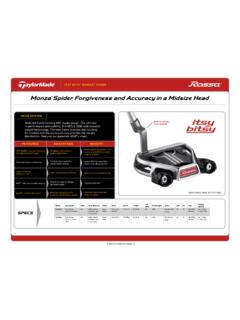Transcription of Itsy Bitsy Spider - alabamawildlife.org
1 Background Info Spiders are not insects even though they are both in the group called arthropods. Spiders are members of the Class Arachnida. This group has two body parts and four pairs of jointed legs instead of three body parts and three pairs of legs like insects. Spiders as a group are considered to be beneficial predators, especially in the garden as they prey upon a host of insects that could cause damage to your produce and flowers. In the following activity (best done in the fall when Spider populations are at their highest and many species have reached maturity), you will construct an orb weav-ing Spider habitat that will enable the students to observe a Spider in your classroom. A yellow garden Spider (Argiope aurantia) or similar species is a good choice to use with this activity. The yellow garden Spider may also be known by other names such as Black and Yellow Garden Spider , Writing Spider , Banana Spider or Corn Spider .
2 These spiders are considered to be harmless to people. This Spider is usually found in areas adjacent to open sunny fields, in tall vegetation like that found in a garden area, or along the eaves of houses or other buildings. The female Spider will most likely be the one you find as they are larger (19-28 mm in length) while the male is smaller (5-9 mm) and builds a much smaller web. The female constructs a circular web that is connected to secure anchors with approximately 4 radial lines. The center of the circular web is filled with a zigzag pattern. While observing this Spider , you will discover that on a daily basis, it will consume the circular interior part of the web and then rebuilds it each morning with fresh silk. In addition, you may also see the Spider oscillating the web. It is believed that this is done to prevent predators from drawing a good bead, and it may also help to fully entangle an insect before it cuts itself loose from the web.
3 In addition to observing the building of the web, students will be able to feed the Spider live insects that they collect around the school grounds. If you have a female Spider , you will most likely get to see the Spider lay her eggs and form an egg sack. Understand that the eggs in this case are most likely going to be sterile unless a male Spider has been able to mate with her. Also, remember that like the Spider in Charlotte s Web, your Spider will die sometime during late fall or early winter so you will want to prepare your students for this act of nature . Preparation Construct the Spider habitat as described under the Procedure steps on page 2. Once you have built the habitat, you will need to collect a live Spider specimen as described above. You may want to set this habitat up outside at first to verify that the Spider is unable to escape. Once you see that the Spider seems to be content with its new home, bring it into the classroom and let the students begin observing.
4 Itsy Bitsy Spider AL A B A M A OU T D O O R CL A S S R O O M AC T I V I T Y Grade Levels K-7th Overview This activity provides an interesting means through which the students are able to observe the behavior of a common garden Spider . They will be able to watch the Spider spin its web, capture and consume its prey, and even form an egg case or sack all within the confines of the classroom. Subject Areas Biology, Environmental Sciences, Language Arts Duration One 45 minute period to set-up the Spider habitat. Daily obser-vation time over several weeks. Learning Objectives Students will 1) learn the differences between an insect and a Spider ; 2) observe how a Spider spins a web and the daily upkeep that the Spider performs; 3) observe the predator and prey relationship as they feed the Spider insects that they collect; and 4) record their observations regarding the Spider and its behavior over a period of several days to weeks Materials Wash tub or plastic tub Forked branch Plaster of Paris Coffee can Water Page 1 of 2 Procedure 1.
5 Locate a forked limb that has a diameter of approximately 1 at the widest end and has two branches that create a fork with each side measuring at least 1/4 in diameter. 2. Cut the limb so that the thickest end has a length from 8 to 12 in and that each of the two sides of the fork are at least 16 long. 3. Using a coffee can or similar container, mix-up enough plaster-of-paris to fill the can from 4-6 inches full. 4. Place the single end of the branch in the plaster so that the forked branches are sticking straight above the can. 5. Using a piece of masking tape, wrap a piece of tape around the branch and then tape the two ends on opposite sides of the can to help keep the branch anchored in place until the plaster hardens. 6. Once the branch is ready, place it in a plastic tub so that can is centered and the tips of the two forked branches extend outward, but just short of the sides of the tub. 7. Place enough water in the tub so that there is approximately 1 of water standing in the bottom of the tub.
6 8. Carefully catch an orb weaving Spider such as a garden Spider and place it on the branch where the fork begins. 9. Once the Spider has the opportunity to explore the branch and realizes it cannot escape the tub because of the water, it will weave a web between the forked branches. 10. Once the Spider has spun its web, the children can catch insects such as grasshoppers, crickets or flies and carefully place them into the web. 11. Once the Spider feels the insect moving in the web, it will move down and inject it with poison and then wrap it with silk Extensions Language Arts: Once the students begin observing the Spider , have them write about their obser-vations in a journal. Why not create a special journal that is just about the Spider and include poetry and drawings? Itsy Bitsy Spider AL A B A M A OU T D O O R CL A S S R O O M AC T I V I T Y Outdoor Classroom Connections This activity will enable the teacher and students to observe the behaviors of a Spider within the confines of the classroom throughout the day.
7 Alabama Course of Study Objectives Science: Kindergarten: 6, 7 & 9 First: 1, 2, 3, & 4 Second: 1, 2, 4, & 6 Third: 2, 3,& 8 Fourth: 2, 5, & 6 Fifth: 9 Seventh: 1, 4, 5 & 7 Vocabulary Arachnid, Spider , insect, predator, prey, circular Literature Connections: White, Charlotte s Web Carle, Eric. Very Busy Spider Glaser, Linda. Spectacular Spiders Humphries, Tudor. Are You a Spider ? Other Related Conservation Education Activities Project WILD Interview a Spider Learning to Look, Looking to See Spider Web Geometry Page 2 of 2 Can with Plaster of Paris Tub Spider & Web Forked branch Water The Alabama Outdoor Classroom Program is a partnership between: Alabama Cooperative Extension System Alabama Wildlife Federation Alabama Department of Conservation & Natural Resources

